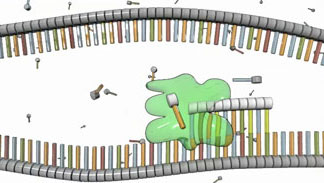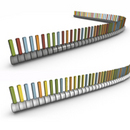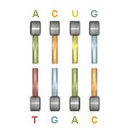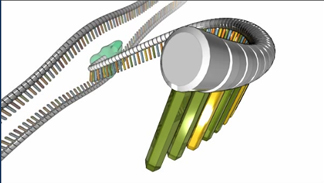Where Would Rna Polymerase Attach

Effigy 2: RNA polymerase (dark-green) synthesizes a strand of RNA that is complementary to the DNA template strand below it.
Once RNA polymerase and its related transcription factors are in place, the single-stranded DNA is exposed and set for transcription. At this point, RNA polymerase begins moving downward the DNA template strand in the 3' to 5' direction, and equally it does and so, it strings together complementary nucleotides. By virtue of complementary base- pairing, this action creates a new strand of mRNA that is organized in the 5' to 3' management. Every bit the RNA polymerase continues down the strand of Dna, more nucleotides are added to the mRNA, thereby forming a progressively longer chain of nucleotides (Effigy 2). This process is called elongation.

Effigy 3: DNA (meridian) includes thymine (red); in RNA (bottom), thymine is replaced with uracil (yellow).
Three of the four nitrogenous bases that make up RNA — adenine (A), cytosine (C), and guanine (G) — are as well found in Deoxyribonucleic acid. In RNA, however, a base chosen uracil (U) replaces thymine (T) as the complementary nucleotide to adenine (Effigy three). This means that during elongation, the presence of adenine in the Dna template strand tells RNA polymerase to attach a uracil in the corresponding area of the growing RNA strand (Figure 4).

Effigy 4: A sample section of RNA bases (upper row) paired with DNA bases (lower row). When this base-pairing happens, RNA uses uracil (yellowish) instead of thymine to pair with adenine (green) in the Deoxyribonucleic acid template below.
Interestingly, this base substitution is not the only divergence between Dna and RNA. A second major difference between the two substances is that RNA is made in a single-stranded, nonhelical class. (Call back, Deoxyribonucleic acid is almost always in a double-stranded helical form.) Furthermore, RNA contains ribose sugar molecules, which are slightly different than the deoxyribosemolecules institute in DNA. Equally its name suggests, ribose has more than oxygen atoms than deoxyribose.
Thus, the elongation period of transcription creates a new mRNA molecule from a single template strand of DNA. Equally the mRNA elongates, it peels away from the template as it grows (Figure 5). This mRNA molecule carries DNA'due south message from the nucleus to ribosomes in the cytoplasm, where proteins are assembled. Nevertheless, earlier information technology tin practise this, the mRNA strand must split up itself from the DNA template and, in some cases, it must also undergo an editing process of sort.

Figure v: During elongation, the new RNA strand becomes longer and longer equally the Dna template is transcribed. In this view, the five' end of the RNA strand is in the foreground. Annotation the inclusion of uracil (yellow) in RNA.
Where Would Rna Polymerase Attach,
Source: http://www.nature.com/scitable/topicpage/the-information-in-dna-is-decoded-by-6524808
Posted by: warrendanythas.blogspot.com


0 Response to "Where Would Rna Polymerase Attach"
Post a Comment